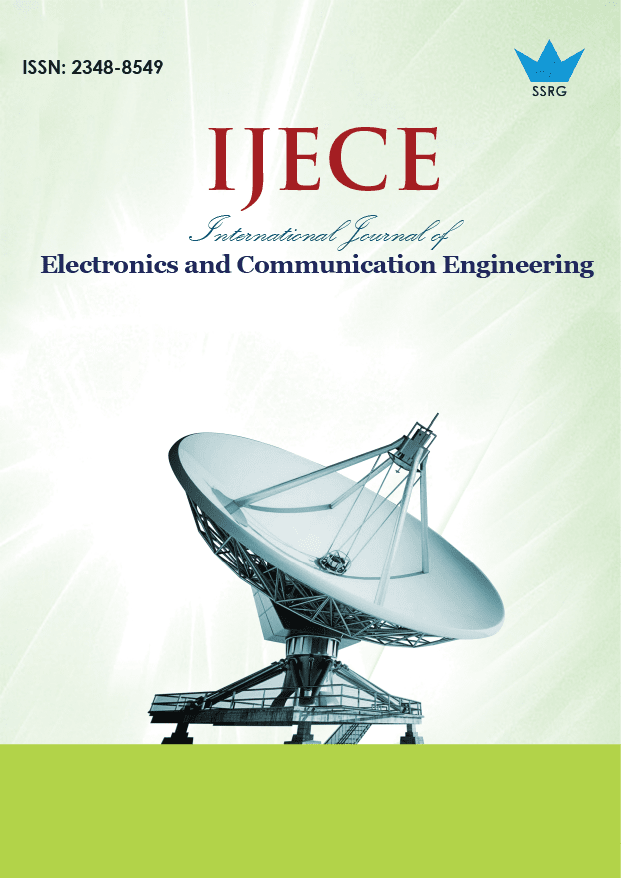Energy-Efficient IoT and RF-Driven Smart Gateway for Transformer Health Monitoring in Cloud-Connected Power Systems

| International Journal of Electronics and Communication Engineering |
| © 2025 by SSRG - IJECE Journal |
| Volume 12 Issue 4 |
| Year of Publication : 2025 |
| Authors : Asmita Sharma, R.P.Agarwal, Rajesh Singh |
How to Cite?
Asmita Sharma, R.P.Agarwal, Rajesh Singh, "Energy-Efficient IoT and RF-Driven Smart Gateway for Transformer Health Monitoring in Cloud-Connected Power Systems," SSRG International Journal of Electronics and Communication Engineering, vol. 12, no. 4, pp. 195-203, 2025. Crossref, https://doi.org/10.14445/23488549/IJECE-V12I4P119
Abstract:
Transformers are pivotal components in power distribution for electrical grids as they directly affect the reliability and efficiency of energy delivery. Effective maintenance of transformers decreases energy losses, improves the grid’s reliability, and contributes to sustainable energy management aligned with the United Nations Sustainable Development Goal (SDG) 7: Affordable and Clean Energy. Conventional methods focus on onsite guarantee inspections, showing blind or gut-feeling maintenance, rather than well-defined maintenance management systems. These limitations have triggered the use and development of IoT and wireless technologies for the remote health monitoring of transformers. The authors designed a smart gateway based on LoRa technology that monitors transformers’ health in real-time. The system integrates two hardware nodes. The first one is the Transformer Health Data Collection Node, which collects operational data that include, but are not limited to, voltage, current, temperature, humidity, and vibration through various sensors. The second one is the LoRa Gateway Node, which processes and uploads the information collected to Blynk Cloud. The Blynk Cloud application allows grid operators to visualize the data in real-time, thus enabling prompt attention to maintenance actions and diagnosing faults within the grid. The system was designed to consume low power and transmit data over long distances while providing reliable remote control using LoRa RF and ESP-01 WiFi. This approach resolves issues related to low energy consumption and access limitations while improving the power systems’ monitoring methods. Moreover, with the aid of cloud computing, it is no longer necessary for workers to supervise the site constantly, which improves efficiency and scalability while also lowering costs. This document describes the specifics of system architecture, the design of devices, the communication protocols used for data exchange, and the interface for monitoring the cloud system. These changes in IoT allow for improving the maintenance of transformers, shortening the downtime needed for repairs, and increasing the reliability of the power distribution arteries with thorough data analysis and real-time monitoring.
Keywords:
Transformer Health Monitoring, LoRa RF, Internet of Things, Sustainable Energy Management, Affordable and Clean Energy.
References:
[1] Kaoutar Talbi et al., “Low-Cost Real-Time Internet of Things-Based Monitoring System for Power Grid Transformers,” International Journal of Electrical and Computer Engineering, vol. 13, no. 3, pp. 2579-2588, 2023.
[CrossRef] [Google Scholar] [Publisher Link]
[2] Rahul Krishnan Pathinarupothi, P. Durga, and Ekanath Srihari Rangan, “IoT-Based Smart Edge for Global Health: Remote Monitoring with Severity Detection and Alerts Transmission,” IEEE Internet of Things Journal, vol. 6, no. 2, pp. 2449-2462, 2018.
[CrossRef] [Google Scholar] [Publisher Link]
[3] Shivakumar G Nayak et al., “Development and Implementation of Transformer Breather Health Monitoring System Using IoT,” IJRASET Journal For Research in Applied Science and Engineering Technology, vol. 11, no. 9, pp. 209-217, 2023.
[CrossRef] [Publisher Link]
[4] Sachin Gee Paul et al., “Transformer Health Monitoring and Protection Using IoT,” IJRASET Journal for Research in Applied Science and Engineering Technology, vol. 10, no. 10, pp. 524-528, 2022.
[CrossRef] [Publisher Link]
[5] Mayur Ramdham et al., “IoT Based Distribution Transformer Health Monitoring System,” IJRASET Journal For Research in Applied Science and Engineering Technology, vol. 10, no. 6, pp. 3945-3950, 2022.
[CrossRef] [Publisher Link]
[6] Mahender Kumar, and Satish Chand, “A Secure and Efficient Cloud-Centric Internet-of-Medical-Things-Enabled Smart Healthcare System with Public Verifiability,” IEEE Internet of Things Journal, vol. 7, no. 10, pp. 10650-10659, 2020.
[CrossRef] [Google Scholar] [Publisher Link]
[7] Nivedhan Senthil Kumar, R. Eranyan, and T.R. Jayapriya, “Internet of Things Based Real Time Transformer Performance Monitoring System,” IJRASET International Journal for Research in Applied Science & Engineering Technology, vol. 7, no. 3, pp. 237-239, 2019.
[CrossRef] [Publisher Link]
[8] Dirman Hanafi, and Zarkhoni Aziz, “Health Monitoring System for Transformer by Using Internet of Things (IoT),” International Journal of Electrical, Energy and Power System Engineering, vol. 5, no. 1, pp. 19-23, 2022.
[CrossRef] [Google Scholar] [Publisher Link]
[9] Jasjit Singh et al., “Health Monitoring Gadgets,” International Conference on Intelligent Computing and Smart Communication 2019, pp. 1547-1552, 2019.
[CrossRef] [Google Scholar] [Publisher Link]
[10] S.B. Joshi et al., “Transformer Health Monitoring Using IoT Based,” IJRASET Journal For Research in Applied Science and Engineering Technology, vol. 11, no. 5, pp. 7594-7597, 2023.
[CrossRef] [Publisher Link]
[11] Beny Nugraha et al., “Analysis of Power Consumption Efficiency on Various IoT and Cloud-Based Wireless Health Monitoring Systems: A Survey,” International Journal of Information Technology and Computer Science, vol. 9, no. 5, pp. 31-39, 2017.
[CrossRef] [Google Scholar] [Publisher Link]
[12] Amol A. Sonune et al., “Condition Monitoring of Distribution Transformer Using IOT,” International Journal of Engineering Research & Technology, vol. 9, no. 6, pp. 335-338, 2020.
[CrossRef] [Google Scholar] [Publisher Link]
[13] K. Somasena Reddy, “A Conceptual Framework for Intelligent Power Distribution Transformers,” International Journal of Innovative Technology and Exploring Engineering, vol. 9, no. 4S2, pp. 97-99, 2020.
[CrossRef] [Publisher Link]
[14] Ammar K. Al Mhdawi, and Hamed Saffa Al-Raweshidy, “A Smart Optimization of Fault Diagnosis in Electrical Grid Using Distributed Software-Defined IoT System,” IEEE Systems Journal, vol. 14, no. 2, pp. 2780-2790, 2019.
[CrossRef] [Google Scholar] [Publisher Link]

 10.14445/23488549/IJECE-V12I4P119
10.14445/23488549/IJECE-V12I4P119